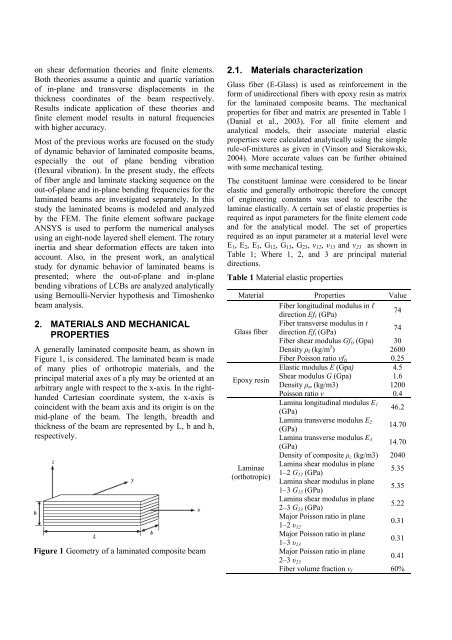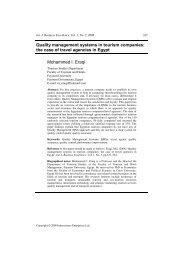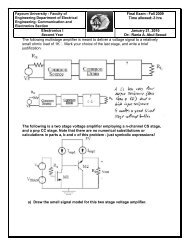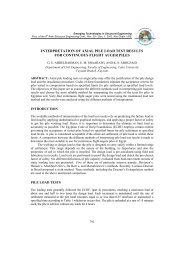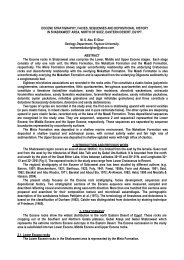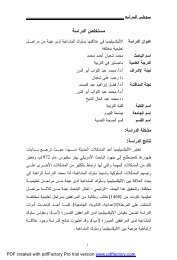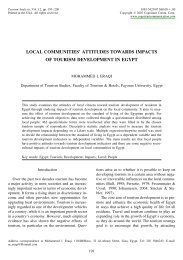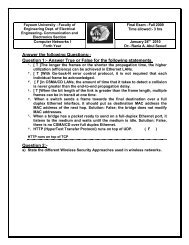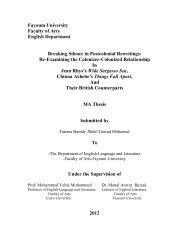EFFECTS OF FIBER ORIENTATION AND LAMINATE STACKING ...
EFFECTS OF FIBER ORIENTATION AND LAMINATE STACKING ...
EFFECTS OF FIBER ORIENTATION AND LAMINATE STACKING ...
Create successful ePaper yourself
Turn your PDF publications into a flip-book with our unique Google optimized e-Paper software.
on shear deformation theories and finite elements.<br />
Both theories assume a quintic and quartic variation<br />
of in-plane and transverse displacements in the<br />
thickness coordinates of the beam respectively.<br />
Results indicate application of these theories and<br />
finite element model results in natural frequencies<br />
with higher accuracy.<br />
Most of the previous works are focused on the study<br />
of dynamic behavior of laminated composite beams,<br />
especially the out of plane bending vibration<br />
(flexural vibration). In the present study, the effects<br />
of fiber angle and laminate stacking sequence on the<br />
out-of-plane and in-plane bending frequencies for the<br />
laminated beams are investigated separately. In this<br />
study the laminated beams is modeled and analyzed<br />
by the FEM. The finite element software package<br />
ANSYS is used to perform the numerical analyses<br />
using an eight-node layered shell element. The rotary<br />
inertia and shear deformation effects are taken into<br />
account. Also, in the present work, an analytical<br />
study for dynamic behavior of laminated beams is<br />
presented; where the out-of-plane and in-plane<br />
bending vibrations of LCBs are analyzed analytically<br />
using Bernoulli-Nervier hypothesis and Timoshenko<br />
beam analysis.<br />
2. MATERIALS <strong>AND</strong> MECHANICAL<br />
PROPERTIES<br />
A generally laminated composite beam, as shown in<br />
Figure 1, is considered. The laminated beam is made<br />
of many plies of orthotropic materials, and the<br />
principal material axes of a ply may be oriented at an<br />
arbitrary angle with respect to the x-axis. In the righthanded<br />
Cartesian coordinate system, the x-axis is<br />
coincident with the beam axis and its origin is on the<br />
mid-plane of the beam. The length, breadth and<br />
thickness of the beam are represented by L, b and h,<br />
respectively.<br />
Figure 1 Geometry of a laminated composite beam<br />
2.1. Materials characterization<br />
Glass fiber (E-Glass) is used as reinforcement in the<br />
form of unidirectional fibers with epoxy resin as matrix<br />
for the laminated composite beams. The mechanical<br />
properties for fiber and matrix are presented in Table 1<br />
(Danial et al., 2003). For all finite element and<br />
analytical models, their associate material elastic<br />
properties were calculated analytically using the simple<br />
rule-of-mixtures as given in (Vinson and Sierakowski,<br />
2004). More accurate values can be further obtained<br />
with some mechanical testing.<br />
The constituent laminae were considered to be linear<br />
elastic and generally orthotropic therefore the concept<br />
of engineering constants was used to describe the<br />
laminae elastically. A certain set of elastic properties is<br />
required as input parameters for the finite element code<br />
and for the analytical model. The set of properties<br />
required as an input parameter at a material level were<br />
E1, E2, E3, G12, G13, G23, v12, v13 and v23 as shown in<br />
Table 1; Where 1, 2, and 3 are principal material<br />
directions.<br />
Table 1 Material elastic properties<br />
Material Properties<br />
Fiber longitudinal modulus in ℓ<br />
direction Efℓ (GPa)<br />
Value<br />
74<br />
Glass fiber<br />
Fiber transverse modulus in t<br />
direction Eft (GPa)<br />
Fiber shear modulus Gfℓt (Gpa)<br />
74<br />
30<br />
Epoxy resin<br />
Laminae<br />
(orthotropic)<br />
Density ρf (kg/m 3 ) 2600<br />
Fiber Poisson ratio νfℓt<br />
0.25<br />
Elastic modulus E (Gpa) 4.5<br />
Shear modulus G (Gpa) 1.6<br />
Density ρm (kg/m3) 1200<br />
Poisson ratio ν 0.4<br />
Lamina longitudinal modulus E1<br />
(GPa)<br />
46.2<br />
Lamina transverse modulus E2<br />
(GPa)<br />
14.70<br />
Lamina transverse modulus E3<br />
(GPa)<br />
14.70<br />
Density of composite ρc (kg/m3) 2040<br />
Lamina shear modulus in plane<br />
1–2 G12 (GPa)<br />
Lamina shear modulus in plane<br />
1–3 G13 (GPa)<br />
Lamina shear modulus in plane<br />
2–3 G23 (GPa)<br />
Major Poisson ratio in plane<br />
1–2 υ12<br />
Major Poisson ratio in plane<br />
1–3 υ13<br />
Major Poisson ratio in plane<br />
2–3 υ23<br />
5.35<br />
5.35<br />
5.22<br />
0.31<br />
0.31<br />
0.41<br />
Fiber volume fraction vf 60%


